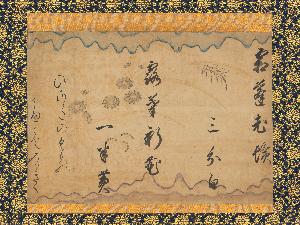Konoe Sakihisa
Konoe Sakihisa
Place: Nakamura
Born: 1536
Death: 1612
Biography:
Biography and Artistic Contributions
Konoe Sakihisa, a Japanese court noble, lived from 1536 to 1612, spanning the Sengoku, Azuchi–Momoyama, and early Edo periods. As a member of the influential Konoe family, a branch of the Fujiwara clan, Sakihisa's life was marked by significant political and military roles. Early Life and Family Born in 1536, Sakihisa was the son of regent Taneie, positioning him within the upper echelons of Japanese nobility. His family's legacy played a crucial role in his early life, setting the stage for his future endeavors.
Artistic and Political Involvement
- Konoe Sakihisa served as kampaku-sadaijin and daijō-daijin, reflecting his rise to junior first rank.
- He was a key figure in the Konoe family's interactions with prominent daimyōs (feudal lords) of the time.
- Sakihisa found favor with Oda Nobunaga and accompanied him on campaigns, further solidifying his position within Japan's complex political landscape.
Notable Artistic Connections and Legacy
- Konoe Sakihisa's daughter, Sakiko, was adopted by Toyotomi Hideyoshi, later becoming a consort to Emperor Go-Yōzei and giving birth to Emperor Go-Mizunoo.
- In 1582, Sakihisa received the appointment as Daijō Daijin, a position he later resigned from the same year.
- His adoption of Hashiba (later Toyotomi) Hideyoshi in 1585 granted Hideyoshi Fujiwara legitimacy, paving the way for his appointment as kampaku.
Art Movement Influences and Legacy
While primarily known for his political and military roles, Konoe Sakihisa's influence on Japanese art, particularly through his connections with the Konoe family's artistic patronage, is noteworthy. The Kanō school style art movement, which dominated Japanese painting during this period, reflects the era's emphasis on vibrant colors and gold leaf, characteristic of the nobility's decorative preferences.
- For a deeper understanding of the Kanō school style art movement, visit The Kanō School Style Art Movement.
- Explore the influence of Chinese painting on Japanese art through Kanō Masanobu's works, such as Zhou Maoshu Appreciating Lotuses.
- Discover the Ukiyo-e art movement, which flourished during the Edo period, at The Museum of Fine Arts (Gifu, Japan) and its Collection.
Conclusion
Konoe Sakihisa's life, though marked by political and military service, indirectly influenced the artistic landscape of Japan's Sengoku, Azuchi–Momoyama, and early Edo periods. His connections with prominent figures like Oda Nobunaga and Toyotomi Hideyoshi further solidify his place in Japanese history.


